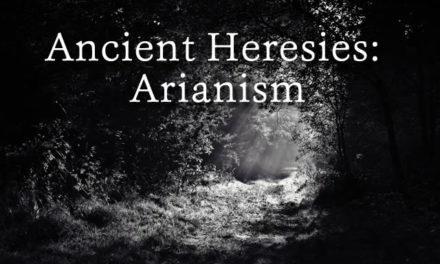Observant people are seeing a multitude of religious expression around the world.
Being thoroughly aware of Truth is vital in being able to discern error.
There is a “revival” of some sort occurring in Lakeland, Florida. At least the enthusiasts say it is a revival. Todd Bentley, a revivalist with Fresh Fire Ministries, is leading the meetings under a big tent that seats 10,000. There are reports of healings, supernatural signs, and even resurrections. Though I don’t recommend Todd Bentley’s “ministry” you can get a glimpse of the goings on by searching for his name on YouTube.
This event is another in a series of similar so-called revivals that include the Toronto event led by Rodney Howard-Browne, the Brownsville “revival” in Pensacola, Florida. Each had manifestations of exotic behaviors including people literally acting like animals. Is this something new? Is this a manifestation of the Holy Spirit? First, it is definitely not new. Second, if it is a manifestation of the Holy Spirit then we have additional and troublesome questions to ask.
Perhaps some historical perspective is in order. Historically revivals have been just that, the renewing of spiritual life in the person. The elements of this begin with the Bible and its frequent call to repentance and a “return to your first love” (Revelation 2:4,5). This call to repentance has always included the elements of recognition of God’s holiness followed by a realization of our sinfulness. God uses this understanding to convict us of our sin that leads us to repentance and submission to His will.
The whole focus in revival is the holiness of God. The First Great Awakening began under the preaching of Jonathan Edwards and his sermon “Sinners In The Hands Of An Angry God.” True revival is never focused on signs and wonders, exciting phenomenon, and human personalities. The reason revival is not man focused is that man is the problem and God is the answer. Our “righteousness” is a filthy rag to Him. However, Satan uses our passions to turn us away from the simple process of repentance and submission. For Satan it is anything but Christ.
During the Second Great Awakening, which lasted from 1800 through 1830, there were exotic manifestations like what we observed in Toronto and Brownsville. These manifestations occurred in the frontier regions of the country. The most significant was the Cane Ridge Revival in Kentucky. Paul Dienstberger describes this phenomenon in the online book in The American Republic: A Nation of Christians (published 2000).
Dienstberger said, “Some came from Tennessee and even from Ohio…. The crowd was overwhelming and estimates ran as high as 25,000. Even Governor James Garrard came the 20 miles from Lexington, the capital and largest town in the state at less than 1,800 population. The multitude was a diverse assemblage of converts from earlier meetings, curiosity seekers, merchants…The most prevalent physical “exercise” was falling down. It was usually accompanied with fainting, some bodily agitation’s, and even a trance or coma…. The religious ecstasy was thought to be a new experience of the Holy Spirit. Barton Stone devoted an entire chapter in his biography to describe the physical wonders. The most dramatic was the “jerks.” A person would fall down and his head and neck and limbs would snap back and forth…. Other bodily signs included: dancing, running, and leap frogging. A confusion of vocal utterances included: barking, shouts, groans, and babbling that was called holy laughter or singing. Treeing the devil was a bizarre attraction. The individual and even groups, usually got down on all fours and barked up the side of a tree. The person was always followed by the crowd, and they shouted and encouraged the actions with “Sic Satan, sic ’em, sic ’em.” It was recommended that dancing and “holy” leap frogging would relieve the condition.”
Those who readily accept this behavior as from the Holy Spirit because it is being exhibited in a Christian setting need to know it is common in non-Christian settings. For instance, we find the same manifestations exhibited in Kundalini Yoga.
There is an almost exact parallel between the Cane Ridge/Toronto/Brownsville/Lakeland “revivals” and the practices and manifestations in Kundalini Yoga. The manifestations in Yoga are called Kriyas. According to online sources “Most kriyas are simple tremors or twitches as tension held in the body, releases. However, they can be quite complex movements, breathing patterns, (pranayama) vocalizations, visions,… the body will do whatever it needs to do, to facilitate the blockage being cleared, and it has all the wisdom of the Collective consciousness, to draw upon. So, a Kriya may take the form of an African Dance, a Sanskrit song, an Aboriginal drum chant, or anything. Energy clearing techniques that have been used by different cultures for thousands of years, tend to have a higher resonance in the Collective, and the body-mind guidance will make use of that unconscious information, bring it forth.” (http://kundalini-teacher.com/symptoms/kriyas.php)
Most Christians watching the Lakeland “revival” feel embarrassed for the church that this is publicly displayed. Even some participants feel a hesitancy at first. This is also consistent with what the above website says about the kriyas. “Some people find kriyas to be a source of embarrassment, especially if they come unexpectedly in public. Issues of embarrassment are caused by ego, and the ideal is to allow the processing and let Goddess handle the reactions. Surrender. However, if you are not ready to do that, sometimes one can negotiate with the Kundalini Shakti, and ask that kriyas only occur in private… but in exchange, agree to spend some private time every day, allowing the body to have kriyas as it will.”
In this writers opinion these exotic behaviors are inconsistent with the way God works among believers. When Paul addressed similar excesses in the church in Corinth he concluded by admonishing them to do everything “decently and in order” (1 Corinthians 14:40). These activities are identical to those in pagan religion. In fact the origin of the term enthusiast comes from the Greek en theos, meaning in god, or god in you.
This was originally used by the pagans to describe those who were possessed of a demon. Of course it does not mean that today but the origin of the term tells us to be on guard against those who claim to be filled with God but are indecent and disorderly.
By David Henke






